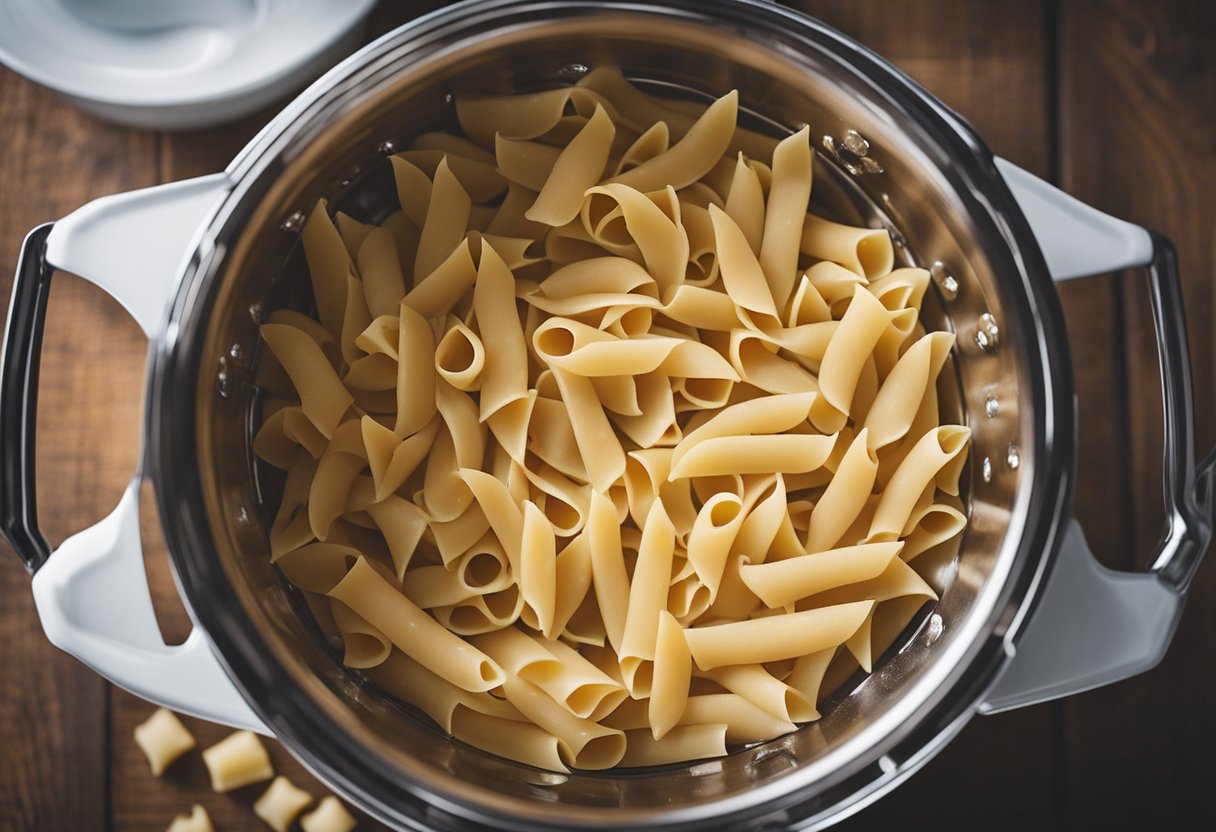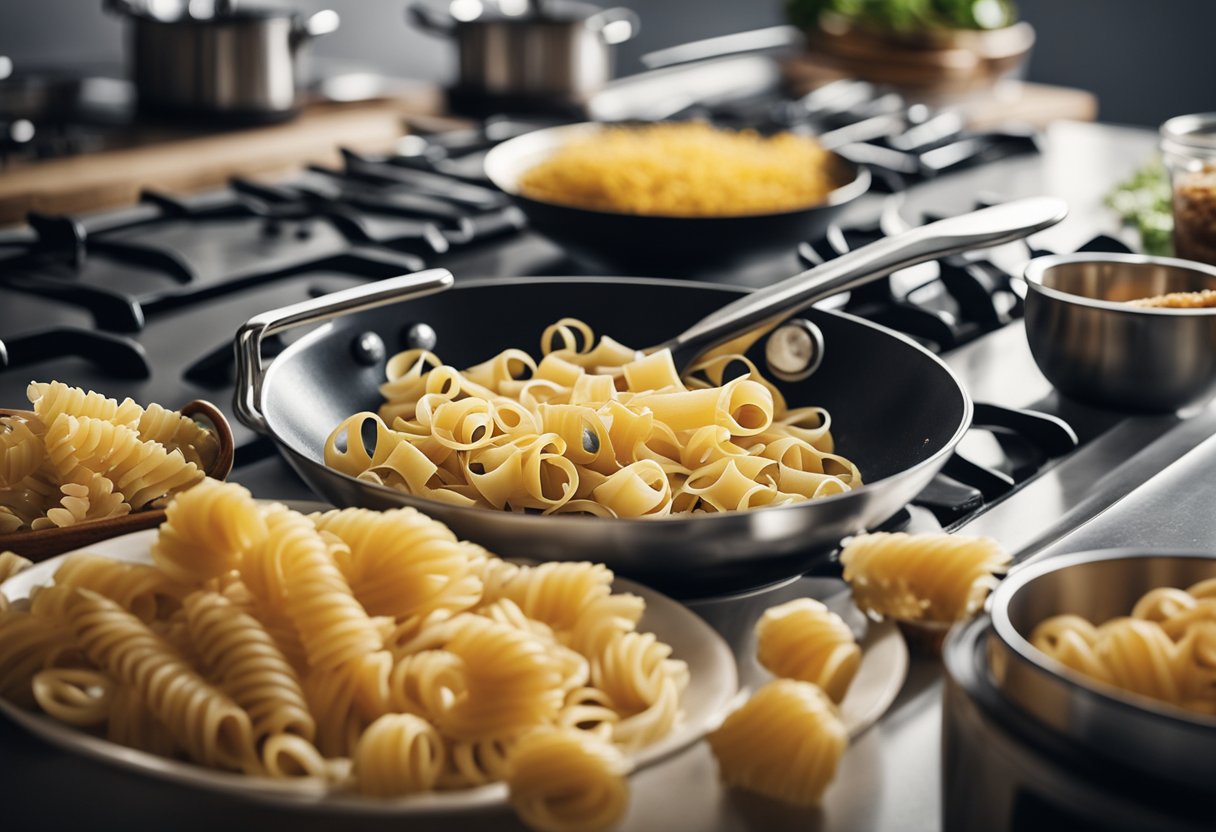Cooking pasta ahead of time is a convenient way to save time and effort in the kitchen, especially when hosting a dinner party or preparing meals in advance.
However, pre-cooked pasta can easily become mushy, dry, or clumped together if not stored or reheated properly. In this article, I will share some tips and tricks on how to cook pasta ahead of time and reheat it while maintaining its quality and flavor.

Choosing the right pasta and prep is essential for cooking pasta ahead of time. Not all pasta shapes and sizes are suitable for pre-cooking, as some may become too soft or break apart.
It’s best to choose pasta shapes that are sturdy and can hold up well to reheating, such as penne, fusilli, or rigatoni. Additionally, it’s crucial to cook the pasta al dente, as it will continue to cook slightly when reheated.
Key Takeaways
- Choose sturdy pasta shapes that can hold up well to reheating, such as penne, fusilli, or rigatoni.
- Cook the pasta al dente to prevent it from becoming too soft or mushy when reheated.
- Store pre-cooked pasta in an airtight container in the fridge for up to three days and reheat it using the boiling water, microwave, or oven method.
Choosing the Right Pasta and Prep

When it comes to cooking pasta ahead of time, choosing the right pasta and prep is crucial. Here are some tips to help you get started:
Selecting Pasta Shapes
Different pasta shapes have different cooking times, so it’s important to choose the right one for your recipe. For example, thin and delicate pasta like angel hair or spaghetti cook quickly, while thicker pasta like fettuccine or penne take a bit longer.
When cooking pasta ahead of time, it’s best to choose shapes that hold up well to reheating, such as penne, rigatoni, or farfalle.
Pre-Cooking Techniques
To ensure that your pasta reheats well, there are a few pre-cooking techniques that you can use. First, make sure to cook your pasta in salted water.
This not only seasons the pasta but also helps to prevent it from sticking together. Additionally, avoid adding oil to the water as it can coat the pasta and prevent it from absorbing the sauce.
When cooking pasta ahead of time, it’s important to cook it al dente, which means that it’s still slightly firm to the bite. This is because the pasta will continue to cook as it reheats, so if it’s already fully cooked, it may become mushy when reheated.
Once your pasta is cooked, drain it and rinse it with cold water to stop the cooking process. You can also toss it with a bit of olive oil to prevent it from sticking together. Finally, store the pasta in an airtight container in the fridge until you’re ready to reheat it.
By following these tips for selecting pasta shapes and pre-cooking techniques, you can ensure that your pasta reheats well and tastes just as good as it did when it was freshly cooked.
Storing Pre-Cooked Pasta
Cooking pasta ahead of time and reheating it later is a convenient way to save time and effort in the kitchen. However, it is essential to store the pre-cooked pasta correctly to prevent it from drying out and losing its texture and flavor.
Cooling and Adding Oil
After cooking the pasta, it is important to cool it down as quickly as possible. You can do this by rinsing it under cold water or placing it in a bowl of ice water. This will stop the cooking process and prevent the pasta from becoming mushy.
Once the pasta is cooled, you can add a little olive oil to prevent it from sticking together. Toss the pasta with a tablespoon or two of olive oil, and then transfer it to an airtight container for storage.
Airtight Containers for Storage
When storing pre-cooked pasta, it is important to use an airtight container to prevent moisture loss and keep the pasta fresh. You can use plastic bags, plastic containers, or glass containers with tight-fitting lids.
If you are using a plastic bag, make sure to remove as much air as possible before sealing it. This will prevent the pasta from drying out and becoming stale.
Once you have stored the pre-cooked pasta in an airtight container, you can keep it in the fridge for up to five days. When reheating the pasta, you can either microwave it or reheat it on the stove with a little bit of water or sauce.
By following these simple tips, you can store pre-cooked pasta correctly and enjoy a quick and easy meal whenever you want.
Reheating Techniques
When it comes to reheating pasta, there are a few techniques that work well. Here are the three most common methods:
Stovetop Reheating
One of the easiest ways to reheat pasta is on the stovetop. Start by bringing a pot of salted water to a boil. Once the water is boiling, add your leftover pasta and let it cook for 30 seconds to 1 minute, or until it is heated through.
Be sure to stir the pasta occasionally to prevent it from sticking together. Drain the pasta and serve with your favorite sauce.
Oven-Based Warming
If you have a little more time, you can use your oven to reheat pasta. Preheat your oven to 350°F. Place your leftover pasta in an oven-safe dish and cover it with aluminum foil.
Bake for 20-30 minutes, or until the pasta is heated through. If your pasta seems dry, sprinkle a little water or broth over it before covering it with foil. This will help to add moisture and prevent it from drying out.
Microwave Method
If you’re short on time, the microwave is a quick and easy way to reheat pasta. Start by placing your leftover pasta in a microwave-safe dish. Add a tablespoon of water or broth to the dish to help add moisture.
Cover the dish with a microwave-safe lid or plastic wrap, leaving a small vent for steam to escape. Microwave the pasta on high for 1-2 minutes, or until it is heated through. Be sure to stir the pasta occasionally to ensure even heating.
No matter which method you choose, be sure to add a little moisture to your pasta to prevent it from drying out. You can also add a little extra sauce or cheese to your pasta to help add flavor and moisture.
With these simple reheating techniques, you can enjoy leftover pasta that tastes just as good as it did the first time around.
Maintaining Quality and Flavor
As a pasta lover, I know how important it is to maintain the quality and flavor of pasta even when reheating. Here are some tips that have helped me keep my pasta fresh and delicious:
Adding Moisture Back to the Pasta
One of the main issues with reheated pasta is that it can become dry. To avoid this, I add moisture back to the pasta before reheating.
I usually save some of the pasta cooking water and add it to the pasta when reheating. This helps to revive the pasta and make it taste fresh again.
Another option is to add a little bit of olive oil or butter to the pasta before reheating. This helps to keep the pasta moist and also adds some extra flavor. However, be careful not to add too much oil or butter as it can make the pasta greasy.
Pairing with the Right Sauce
When reheating pasta, it’s important to pair it with the right sauce. Some sauces work better than others when reheated. For example, tomato-based sauces tend to hold up well when reheated, while cream-based sauces can separate and become oily.
To avoid this issue, I usually add a little bit of milk or cream to the sauce when reheating. This helps to keep the sauce from separating and also adds some extra creaminess.
Another option is to add a little bit of Parmesan cheese to the sauce. This helps to thicken the sauce and also adds some extra flavor.
When pairing the pasta with the sauce, I also consider the type of pasta. Some pastas work better with certain sauces than others. For example, spaghetti works well with tomato-based sauces, while fettuccine works well with cream-based sauces.
In conclusion, by adding moisture back to the pasta and pairing it with the right sauce, you can maintain the quality and flavor of your reheated pasta.
Tips and Tricks for Best Results
Cooking in Batches for Events
If you’re cooking pasta for a large event or meal, it’s important to cook it in batches. This will ensure that each batch is cooked evenly and doesn’t become overcooked or undercooked.
To do this, I recommend boiling water in a large pot and adding a small amount of pasta at a time. This will help the water maintain its temperature and prevent the pasta from sticking together.
Once the pasta is cooked, I recommend transferring it to a sheet pan to cool. This will prevent the pasta from continuing to cook and becoming mushy. Once the pasta is cool, you can store it in an airtight container in the refrigerator for up to 48 hours.
Avoiding Common Mistakes
Cooking pasta ahead of time can be a versatile and time-saving technique, but it’s important to avoid common mistakes. One mistake is adding oil to the pasta water.
This can cause the pasta to become greasy and prevent it from absorbing sauces properly. Instead, I recommend using a tablespoon of salt per gallon of water to add flavor and prevent the pasta from sticking together.
Another mistake is not saving some of the cooking water. This starchy water can be used to thin out sauces or add flavor to the pasta. I recommend saving about a cup of the cooking water and adding it to the pasta when reheating.
Finally, it’s important to reheat the pasta properly. I recommend using a low temperature and adding a little moisture to prevent the pasta from becoming dry. You can reheat the pasta in the oven, on the stovetop, or in the microwave depending on your preference.
By following these tips and tricks, you can cook pasta ahead of time and reheat it for a quick and easy meal.
Frequently Asked Questions
What is the best method to pre-cook pasta for a buffet and keep it warm?
When pre-cooking pasta for a buffet, it is important to keep it warm to prevent it from becoming dry and unappetizing.
One of the best methods to keep pre-cooked pasta warm is to place it in a chafing dish or slow cooker on the warm setting. Be sure to stir the pasta occasionally to prevent it from sticking together.
How can I make fresh pasta in advance for a large gathering?
Making fresh pasta in advance for a large gathering can be a time-saver, but it requires some planning. The best method is to make the pasta dough ahead of time and store it in the refrigerator for up to 24 hours.
When ready to cook, roll out the pasta and cut it into the desired shape. Fresh pasta cooks quickly, so be sure to keep an eye on it and test it frequently for doneness.
What are the steps to cook and reheat pasta for mac and cheese prep?
To cook pasta for mac and cheese prep, bring a large pot of salted water to a boil and cook the pasta until al dente. Drain the pasta and rinse it under cold water to stop the cooking process.
To reheat the pasta for mac and cheese, place it in a baking dish and mix it with the cheese sauce. Cover the dish with foil and bake it in a preheated oven at 350°F for 20-25 minutes, or until heated through.
Is it possible to pre-cook and freeze pasta for later use?
Yes, it is possible to pre-cook and freeze pasta for later use. To do so, cook the pasta until al dente, drain it, and rinse it under cold water. Toss the pasta with a little bit of olive oil to prevent it from sticking together, and then place it in a freezer-safe container or bag.
The pasta can be frozen for up to 2-3 months. To reheat, simply thaw the pasta in the refrigerator overnight and then reheat it in a saucepan or microwave.
How do caterers maintain the warmth and quality of pasta during events?
Caterers often use chafing dishes or warming trays to keep pasta warm during events. They may also add a little bit of hot water to the bottom of the dish to create steam, which helps to keep the pasta moist.
To maintain the quality of the pasta, caterers may also cook it in smaller batches and replenish it as needed.
Can I prepare pasta salad by cooking the pasta ahead of time?
Yes, you can prepare pasta salad by cooking the pasta ahead of time. To do so, cook the pasta until al dente, drain it, and rinse it under cold water.
Toss the pasta with a little bit of olive oil to prevent it from sticking together, and then refrigerate it until ready to use. When ready to make the pasta salad, combine the pasta with the other ingredients and toss it with the dressing.







